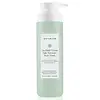What's inside
What's inside
 Key Ingredients
Key Ingredients

No key ingredients
 Benefits
Benefits

 Concerns
Concerns

 Ingredients Side-by-side
Ingredients Side-by-side

Water
Skin ConditioningSodium C14-16 Olefin Sulfonate
CleansingCocamidopropyl Hydroxysultaine
CleansingDimethyl Lauramide/Myristamide
EmulsifyingGlycerin
HumectantRiboflavin
Cosmetic ColorantFolic Acid
Skin ConditioningBiotin
AntiseborrhoeicPantothenic Acid
Skin ConditioningNiacin
SmoothingCyanocobalamin
Skin ConditioningThiamine Hcl
MaskingPyridoxine
Skin ConditioningLeuconostoc/Radish Root Ferment Filtrate
AntimicrobialHydroxypropyl Guar Hydroxypropyltrimonium Chloride
Tetrasodium Glutamate Diacetate
Citric Acid
BufferingSodium Hydroxide
BufferingSodium Chloride
MaskingSodium Ferrocyanide
Sodium Benzoate
MaskingPotassium Sorbate
PreservativeParfum
MaskingLimonene
PerfumingWater, Sodium C14-16 Olefin Sulfonate, Cocamidopropyl Hydroxysultaine, Dimethyl Lauramide/Myristamide, Glycerin, Riboflavin, Folic Acid, Biotin, Pantothenic Acid, Niacin, Cyanocobalamin, Thiamine Hcl, Pyridoxine, Leuconostoc/Radish Root Ferment Filtrate, Hydroxypropyl Guar Hydroxypropyltrimonium Chloride, Tetrasodium Glutamate Diacetate, Citric Acid, Sodium Hydroxide, Sodium Chloride, Sodium Ferrocyanide, Sodium Benzoate, Potassium Sorbate, Parfum, Limonene
Water
Skin ConditioningSodium Cocoyl Methyl Isethionate
Sodium Cocoyl Isethionate
CleansingCocamidopropyl Hydroxysultaine
CleansingCocamidopropyl Betaine
CleansingGlycerin
HumectantCoco-Glucoside
CleansingPolyquaternium-73
Anthemis Nobilis Flower Oil
MaskingNiacinamide
SmoothingPanthenol
Skin ConditioningCamellia Sinensis Leaf Extract
AntimicrobialAscorbyl Glucoside
AntioxidantHippophae Rhamnoides Fruit/Seed Oil
AntimicrobialPyrus Malus Fruit Extract
Skin ConditioningPolyquaternium-10
Magnesium PCA
HumectantManganese PCA
HumectantZinc PCA
HumectantSodium PCA
HumectantSodium Lactate
BufferingPCA
HumectantSerine
MaskingAlanine
MaskingGlycine
BufferingGlutamic Acid
HumectantLysine Hcl
Skin ConditioningThreonine
Arginine
MaskingProline
Skin ConditioningLauryl Glucoside
CleansingTocopheryl Acetate
AntioxidantBetaine
HumectantCaprylyl Glycol
EmollientDidecyldimonium Chloride
EmulsifyingMethylpropanediol
SolventPolyquaternium-80
CleansingChamomilla Recutita Flower Extract
MaskingCitrus Aurantium Bergamia Fruit Extract
Skin ConditioningCitrus Limon Peel Extract
EmollientLavandula Angustifolia Flower/Leaf/Stem Extract
MaskingRosmarinus Officinalis Leaf Extract
AntimicrobialRubus Idaeus Fruit Extract
AstringentSalvia Officinalis Leaf Extract
CleansingVanilla Planifolia Fruit Extract
Skin ConditioningDecyl Glucoside
CleansingTetrasodium Glutamate Diacetate
Citric Acid
BufferingWater, Sodium Cocoyl Methyl Isethionate, Sodium Cocoyl Isethionate, Cocamidopropyl Hydroxysultaine, Cocamidopropyl Betaine, Glycerin, Coco-Glucoside, Polyquaternium-73, Anthemis Nobilis Flower Oil, Niacinamide, Panthenol, Camellia Sinensis Leaf Extract, Ascorbyl Glucoside, Hippophae Rhamnoides Fruit/Seed Oil, Pyrus Malus Fruit Extract, Polyquaternium-10, Magnesium PCA, Manganese PCA, Zinc PCA, Sodium PCA, Sodium Lactate, PCA, Serine, Alanine, Glycine, Glutamic Acid, Lysine Hcl, Threonine, Arginine, Proline, Lauryl Glucoside, Tocopheryl Acetate, Betaine, Caprylyl Glycol, Didecyldimonium Chloride, Methylpropanediol, Polyquaternium-80, Chamomilla Recutita Flower Extract, Citrus Aurantium Bergamia Fruit Extract, Citrus Limon Peel Extract, Lavandula Angustifolia Flower/Leaf/Stem Extract, Rosmarinus Officinalis Leaf Extract, Rubus Idaeus Fruit Extract, Salvia Officinalis Leaf Extract, Vanilla Planifolia Fruit Extract, Decyl Glucoside, Tetrasodium Glutamate Diacetate, Citric Acid
 Reviews
Reviews

Ingredients Explained
These ingredients are found in both products.
Ingredients higher up in an ingredient list are typically present in a larger amount.
Citric Acid is an alpha hydroxy acid (AHA) naturally found in citrus fruits like oranges, lemons, and limes.
Like other AHAs, citric acid can exfoliate skin by breaking down the bonds that hold dead skin cells together. This helps reveal smoother and brighter skin underneath.
However, this exfoliating effect only happens at high concentrations (20%) which can be hard to find in cosmetic products.
Due to this, citric acid is usually included in small amounts as a pH adjuster. This helps keep products slightly more acidic and compatible with skin's natural pH.
In skincare formulas, citric acid can:
While it can provide some skin benefits, research shows lactic acid and glycolic acid are generally more effective and less irritating exfoliants.
Most citric acid used in skincare today is made by fermenting sugars (usually from molasses). This synthetic version is identical to the natural citrus form but easier to stabilize and use in formulations.
Read more about some other popular AHA's here:
Learn more about Citric AcidCocamidopropyl Hydroxysultaine is a synthetic cleansing agent, though it is derived from coconut oil.
It is used to enhance the texture of products by boosting lather and thickening the texture. As a cleanser, Cocamidopropyl Hydroxysultaine is mild.
Glycerin is already naturally found in your skin. It helps moisturize and protect your skin.
A study from 2016 found glycerin to be more effective as a humectant than AHAs and hyaluronic acid.
As a humectant, it helps the skin stay hydrated by pulling moisture to your skin. The low molecular weight of glycerin allows it to pull moisture into the deeper layers of your skin.
Hydrated skin improves your skin barrier; Your skin barrier helps protect against irritants and bacteria.
Glycerin has also been found to have antimicrobial and antiviral properties. Due to these properties, glycerin is often used in wound and burn treatments.
In cosmetics, glycerin is usually derived from plants such as soybean or palm. However, it can also be sourced from animals, such as tallow or animal fat.
This ingredient is organic, colorless, odorless, and non-toxic.
Glycerin is the name for this ingredient in American English. British English uses Glycerol/Glycerine.
Learn more about GlycerinTetrasodium Glutamate Diacetate is a chelating agent. Chelating agents help prevent metal ions from binding to other ingredients. This helps prevent unwanted effects and reactions from a product. These metal ions may come from water and are found in miniscule amounts.
Tetrasodium Glutamate Diacetate can also help other preservatives be more effective.
Water. It's the most common cosmetic ingredient of all. You'll usually see it at the top of ingredient lists, meaning that it makes up the largest part of the product.
So why is it so popular? Water most often acts as a solvent - this means that it helps dissolve other ingredients into the formulation.
You'll also recognize water as that liquid we all need to stay alive. If you see this, drink a glass of water. Stay hydrated!
Learn more about Water